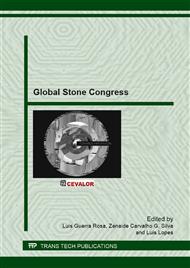[1]
M. Julivert, J.M. Fontbote, A. Ribeiro and L.E. Nabais Conde: Mapa Tectonico de la Peninsula Ibtrica y Baleares E. 1: 1. 000. 000, Inst. Geol. Min. Esp. Madrid (1972).
Google Scholar
[2]
A. Ribeiro, E. Pereira and R. Dias, in: Pre-Mesozoic Geology of Iberia, edited by R.D. Dallmeyer and E. Martinez-Garcia, Berlin Heidelberg: Springer-Verlag (1990).
Google Scholar
[3]
E. Pereira, in: E. Pereira, coord. Carta Geológica de Portugal, Notícia Explicativa da Folha 2 (2006).
Google Scholar
[4]
E. Pereira, A. Ribeiro, in: E. Pereira, coord. Carta Geológica de Portugal, Notícia Explicativa da Folha 2 (2006).
Google Scholar
[5]
A. Ribeiro: Mem. Serv. Geol. Portugal, N.S., 24 (1974) 168 pp.
Google Scholar
[6]
F. Noronha, J.M.F. Ramos, J.A. Rebelo, A. Ribeiro and M.L. Ribeiro: Bol. Soc. Geol. Portg., 21, 2/3 (1979) pp.227-237.
Google Scholar
[7]
M.A.M. Ribeiro: PhD Thesis, Faculdade de Ciências da Universidade do Porto (1998) 231 pp.
Google Scholar
[8]
R. Arenas, and J.R.M. Catalán: Tectonophysics, 365 (2003) pp.143-164.
Google Scholar
[9]
F. Noronha, M.A. Ribeiro, A. Almeida, A. Dória, A. Guedes, A. Lima, H.C. Martins, H. Sant'Ovaia, P. Nogueira, T. Martins, R. Ramos, R. Vieira, in: Geologia de Portugal no contexto da Ibéria, edited by R. Dias, A. Araújo, P. Terrinha and J. Kulberg, Univ. Évora, Évora (2006).
Google Scholar
[10]
Carta Geológica de Portugal 1: 200 000, Folha 2, Instituto Geológico e Mineiro, Portugal, E. Pereira (Coord) (2000).
Google Scholar
[11]
S. Aires, C. Carvalho, F. Noronha, A. Casal Moura and J. Farinha Ramos: Congress Minutes, Global Stone Congress (2012).
Google Scholar
[12]
C. Carvalho, S. Aires, F. Noronha, A. Casal Moura and J. Farinha Ramos: Congress Minutes, Global Stone Congress (2012).
Google Scholar
[13]
M.B. Sousa: PhD Thesis, Universidade de Coimbra (1982) 222 pp.
Google Scholar
[14]
M.B. Sousa, A.D. Sequeira, J. Cotelo Neiva, A. Neiva and M. Azevedo: Folha 10-D (Alijó), Carta Geológica de Portugal 1: 50 000 (1987).
Google Scholar
[15]
R. Dias, C. Coke and A. Ribeiro, in: Geologia de Portugal no contexto da Ibéria edited by R. Dias, A. Araújo, P. Terrinha and J. Kulberg, Univ. Évora, Évora, (2006).
Google Scholar
[16]
N. Moreira, M. Burcio, R. Dias, R. Coke: Com. Geológicas, 97 (2010) pp.147-172.
Google Scholar


